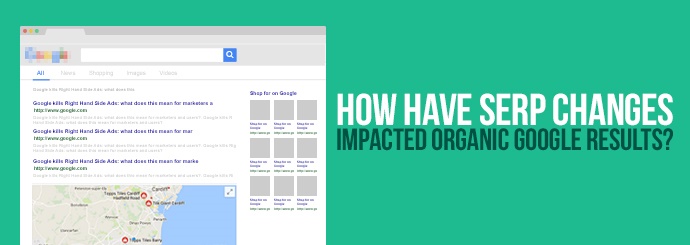
When most of us want to buy something, find a location, or get the answer to a question, we go to Google, right? We like the results, we’re used to how it works...we even use the word 'Google' as a verb to mean 'search for information about'. No wonder Google is the go-to search engine for the majority of Internet users.
Today, we'd like to take a look at whether this pronounced user preference for Google might wane due to the ever-changing appearance of their results pages, or if - on the contrary - these changes have helped to make the search engine even better. Before we can answer this question, we first need to understand which aspects of Google have changed and the effects of those alterations.
As you probably know, the pages that appear when you search for something in any search engine (Google, Bing, Yahoo, etc.) are known as SERPs (Search Engine Results Pages). Over the past year or two, Google have repeatedly changed the way their own SERPs look, and the compounded effect of their changes - particularly in the last year - has seen the traditional organic results pushed further and further down the page.
In this article, we’ll attempt to assess the impact of the changing face of the Google SERPs on organic results.
So How Have Things Changed?
More Ad Space
Firstly, there are now more paid adverts at the top of the SERPs than ever before. In February 2016, Google began to show as many as 4 AdWords ads at the top of the SERP, where once there were only 2 at most. This inevitably began to push organic results further down the page. (Interestingly, up to 3 ads now appear at the bottom of the results page too.)
At the present time, paying for ads through Google AdWords is the easiest way to gain visibility on the SERPs - provided you have a big enough budget, of course! Google place their adverts before organic results because it's in their financial interest to do so - they get money every time somebody clicks an AdWords ad. Google ads have been around for many years and most users are more than used to seeing them at the top of the SERPs, and so it seems unlikely that people will stop using the search engine because of this change; however, if Google continue to increase the number of ads displayed before their organic search results, the number of people clicking on those organic results will likely get smaller and smaller.
Here is a typical Google SERP in which the ads are prioritised and take up most of the space above the fold (the point where you have to scroll down to see more). Notice that the only non-paid search result displayed above the fold is the location of a nearby retailer.

Note also that each individual AdWords ad takes up quite a lot of space by itself - this is due to the addition of 'ad extensions' such as review ratings and additional links.
Featured Snippets
Another relatively new feature that pushes the traditional organic results further down the SERP is the featured snippet, which is now considerably more common than it used to be. In short, a featured snippet is a brief extract from a web page that Google thinks will serve as a handy, concise answer to the query you entered. Although these are organic rather than paid, they still take up a fairly large chunk of real estate near the top of the SERP.
Featured snippets are a game-changer for the simple reason that, when they appear, they appear above all traditional organic listings. For some searches, all that's now visible above the fold is a featured snippet and the paid ads section, meaning that these snippets are now arguably more valuable than the coveted #1 organic position. (Some people have even called the featured snippet slot 'position 0' or 'rank 0'). The introduction of featured snippets has changed the way people use Google as they provide users with answers without even requiring them to click onto a web page.
Here's what a featured snippet looks like:
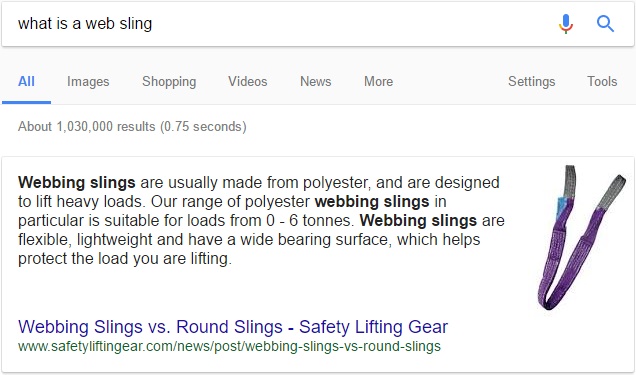
Click here to find out how to gain the featured snippet spot for your keywords.
Rich Cards
Rich cards are another way for Google to give you information in the body of the SERP itself (instead of requiring you to click through to a web page). For example, if you search for the title of a film, a rich card with the movie poster, release date, ratings, et cetera will all appear in the form of a rich card:
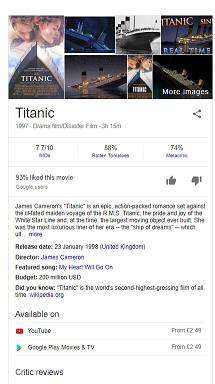
Other types of rich cards may be displayed when searching for courses, recipes or events: Google will supply a list of what it finds on offer, rather than having the user manually compare lots of websites one at a time.
As with snippets, this feature allows Google users to get the answers they need without ever having to click onto a website. Rich cards and featured snippets have definitely made things easier for the user, but whether they have made things easier for business owners is a different question.
Local Results (Map Pack)
The map pack is what we call the group of localised results that appears when Google thinks you're searching for a business or a location in a specific place. For instance, if you search for 'tile shop' and Google sees that you're currently in Dinas Powys, your SERP might include a map pack like this one:
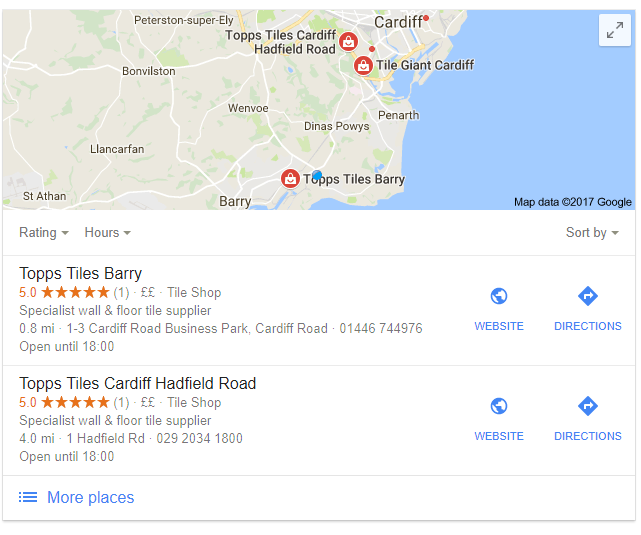
This is a vastly useful feature for Google users as it allows them to see what's around them at a glance. These results are organic (not paid) and display business information clearly and concisely, so it is a useful feature for business owners as well. The only thing you need to do to be included in this section is to provide your business information to Google through Google My Business.
Shopping Results
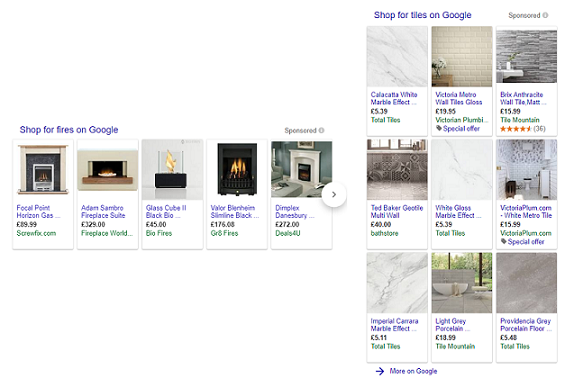
AdWords ads aren't the only paid results you might see within the Google SERP these days. There are also Google Shopping results: product-specific listings that appear when your query indicated a desire to buy something. Each Shopping ad includes a price, a picture, and the name of the product in question, along with the name of the website that sells it. Once again, this has definitely improved the experience for the user as they can view and compare an array of information right there on the SERP.
However, as the size and volume of these Shopping ads increase, the organic search engine results are getting pushed further down the page and becoming more visually unappealing compared to the snazzy product images. This decreases the chance of organic search results gaining clicks/conversions, while potentially increasing the number of businesses that might wish to start using Google Ads.
AMP Results

AMP (Accelerated Mobile Page) results appear when a website has stripped their pages down to the bare necessities so as to improve loading speed on mobile devices. This means taking out unnecessary styling, formatting, bells and whistles while compressing image files and the like to make them as small and as speedy as possible. When a search occurs on a smartphone, Google may prioritise AMP results as these will theoretically deliver a superior user experience.
Many sites are now striving to make their web pages as lightweight as possible using Google's AMP technology. This may mean that non-AMP pages are increasingly left behind as users learn to favour organic results that load more or less instantaneously.
Less Space
With all of the above features and listings jockeying for position, the competition for space on the Google SERP is tougher than ever before. Even if a business ranks towards the top of the traditional organic listings, it will now be much lower down the page overall.
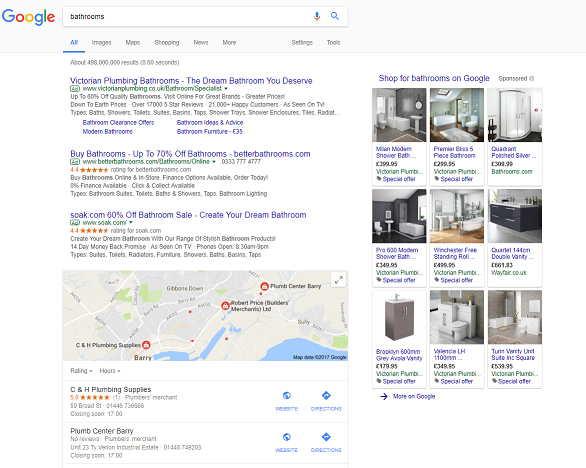
In this example, not a single traditional organic result is visible above the fold. Instead, the screen is filled with AdWords ads, map listings, and Google Shopping results.
What is the impact of these SERP changes?
As you can see in the image above, paid ads now dominate the top of many SERPs (particularly where the search term is popular and highly competitive). The face of the Google SERP is in constant flux, but it's a fairly safe bet that AdWords will continue to be prioritised. This means that businesses who rely primarily on organic Google traffic may be in for a rough time; for instance, ranking in the 6th organic position for a popular keyword might have driven a lot of traffic to your site in the past, but that #6 slot may now be so far down the page it scarcely receives any clicks at all.
However, it's not necessarily all bad news. Although the traditional organic listings have been pushed down, there is still plenty of organic opportunity above the fold in the form of featured snippets, rich cards, and the map pack.
At the beginning of this article, we looked to address whether all of these SERP changes will impact the way people use Google. To answer that question, we believe Google works to make their SERPs the best they can possibly be for the user (while also endeavouring to maximise their own profits in the process). Google users can gain information quicker than ever before and the SERPs help them make shopping decisions more easily by comparing multiple websites' offerings at a glance. Increasing the number of AdWords ads at the top of the SERP seems to have been chiefly a money-motivated decision, but to be fair, the increasing prevalence of Shopping ads is arguably a user-motivated development, making it easy for searchers to view and evaluate lots of different products in seconds. Businesses may have been adversely affected by the decreased focus on standard organic results, but at the end of the day, Google are more interested in satisfying the people who use Google to search than in placating the business owners who use Google to drive traffic to their websites.
What can businesses affected by these changes do?
The preference for paid ads over organic results doesn’t look like a trend that will reverse any time soon, meaning that businesses must continue to work harder at their SEO to appear towards the very top of the organic search results. To boost organic traffic and CTR, try to write content that targets the featured snippet box, and make sure you're listed on Google My Business so that you show up in the map pack.
Inevitably, it may also be time to review your paid marketing strategy (or indeed implement one for the first time). If Google AdWords and Google Shopping continue to dominate the top of the SERPs and it is your goal to be a part of that space, budgeting more money for paid advertising may be key. Ultimately, it is a good idea for businesses to try to appear in both the organic and paid results to maximise their visibility, so refreshing your content and paid advertising strategies is the key to staying relevant in the ever-changing SERP landscape.
Need help driving organic or paid traffic to your website? Get in touch with the Designer Websites team today - our experts will be more than happy to assist you!